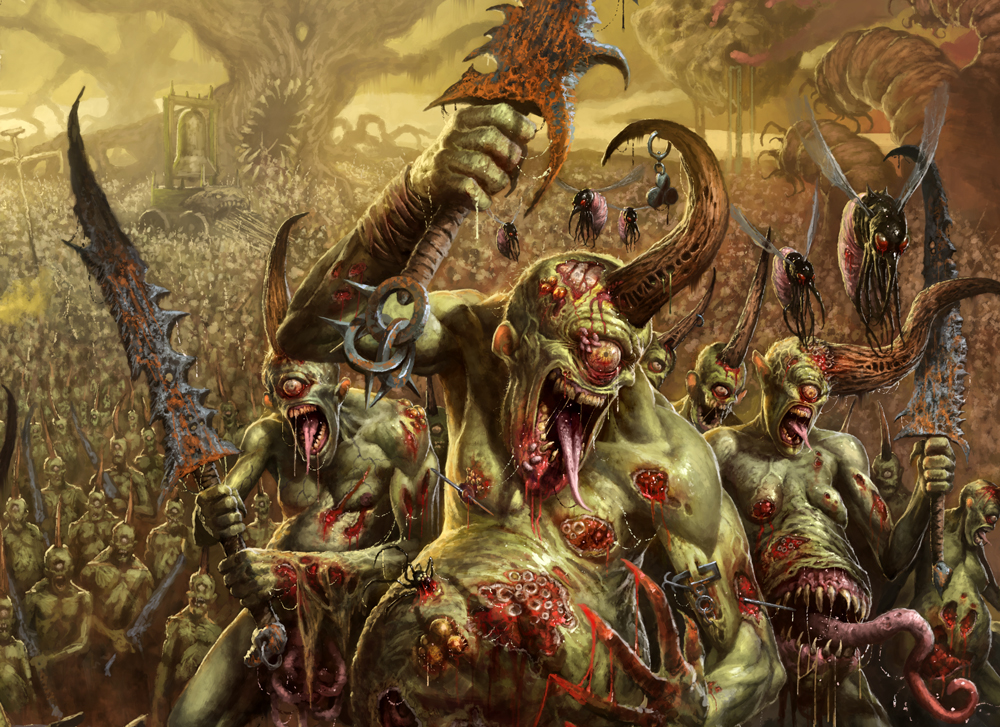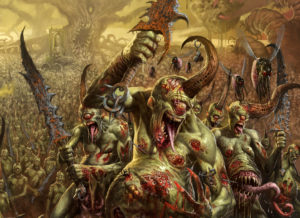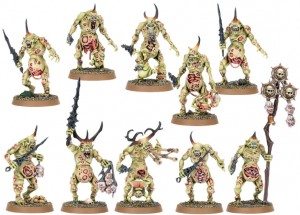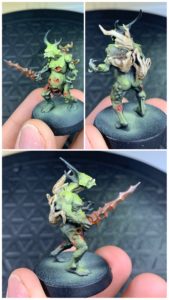Charlie here from 40kDiceRolls, here again, to discuss one of the best troop choices for Daemons, Plaguebearers. As always, for more tactics articles, check out the Tactics Corner!
A lesser daemon of Nurgle created by the Papa himself to count and categorize the numerous diseases in existence. They trod into battle surrounded by clouds of thick, disease-ridden flies and are armed with plague-carrying swords. Not at all malicious, these footsoldiers of Nurgle only wish to spread the fecund genius of Nurgle throughout all of existence and bring about the eventuality of the degradation of the entire cosmos. Fun stuff.
On the tabletop, Plaguebearers consist of at least 10 models but up to 30 in a single unit. They are a troop choice.
Plaguebearer
| M | WS | BS | S | T | W | A | Ld | Sv |
| 5″ | 4+ | 4+ | 4 | 4 | 1 | 1 | 7 | 6+ |
One model in the unit is a Plagueridden (basically the “Seargent” whose stats match the above but with one more attack).
Wargear
Each Plaguebearer is armed with a plaguesword (melee S[User] AP0 D1, reroll failed wound rolls).
Special Rules
- Disgustingly Resilient
- 5+++
- Daemonic
- 5++
- Daemonic Ritual
- Can be summoned
- Cloud of Flies
- -1 to hit for any phase in which they start the phase with 20 or more models
- Instrument of Chaos
- Add 1 to Advance and Charge rolls
- Daemonic Icon
- If you roll a 1 for a Morale test, they auto-pass, losing no models. Further, roll a D6 and that many slain plaguebearers are returned to the unit.
Tactics
As referenced in rvd1ofakind’s Daemon Troop review, Plaguebearers are one of, if not the best troop choice in the game for several reasons. At 7 points each, they are affordable in droves. This is great when you consider that their cloud of flies special rule rewards massive droves of them – preferably max size units of 30 so as to keep that -1 as long as possible. For every 10 models in the unit, one plaguebearer may take an Icon as well as an Instrument (not on the same dude, though). The instrument at least is generally advisable. Extra movement on the advance is nice and since they have no shooting, you’ll be advancing them up the board most games for at least a turn. The plus one to the charge rolls is pretty huge too, taking your odds of success from a ~27% success rate to a ~41% success rate.
This increase to movement via Instruments is just the tip of the iceberg of how to turn a seemingly slow and static unit into a frighteningly fast unit that can surprise many unseasoned players. Plaguebearers start with a solid statline and rules but then are greatly complemented by supporting units and stratagems. The most obvious support character for Plaguebearers is the Spoilpox Scrivener who gives a couple of great bonuses to this unit. To start with, he adds 2″ to all <Plaguebearer> <Infantry> units (Plaguebearers, Scrivener, Bilepiper, Slimux, and Poxbringers all have these keywords) which gives them all M7″. Furthermore, all <Plaguebearer> units get +1 to hit with exploding 7’s (a 6 modified to a 7) generating another attack. While the primary use of Plaguebearers is board control, screening, and general durability, a max size unit has 31 hits and as we will see, they can be a surprising source of damage in the right scenario.
And that’s really what it comes down to – Plaguebearers can surprise your opponent in both how resilient they are, how quick they move, and how much damage they can do. At first glance, this isn’t obvious so let’s dig deeper. On top of their inherent -1 To-Hit by having more than or equal to 20 models at the start of a phase, they have their 5++/5+++ which is quite decent at mitigating damage. Let’s envision the scenario where you have Pask firing 20 S5 Ap0 D1 shots into a 30 man Plaguebearer unit, twice due to the Grinding Advance rule. How many models would you guess are killed? Just with their inherent resilience, about 9 should die on average, with 10 or less being fairly common (only about a 30% chance to kill at least 11). Even with 40 shots, your opponent will most likely need to put more firepower into the unit to avoid another turn at them being -1 To-Hit. But this is just their base resiliency, there are ways you can make them even harder to kill. For instance, you could use the 2CP stratagem Warp Surge to give them a +1 to their Invulnerable save. You could use a Poxbringer to cast Miasma of Pestilence on them for an additional -1 To-Hit. If you did both of those things, those same 40 shots are only going to kill around 30-40 points worth of Plaguebearers.

If you can force your opponent to have to shoot at these either because that’s all they can shoot at or because they’re holding some key objective, you’re doing it right. But that means that you will be losing Plaguebearers and that generally means you’ll be making morale tests. Their Ld7 is ok, but you’ll end up losing a few to morale each turn which will chip away at that magic number of 20 models that is needed for the -1 To-Hit. Ways to mitigate against this are of course to auto-pass for 2CP and support characters. The Great Unclean one can grant nearby Plaguebearers the ability to use its leadership (Ld10) which is nice, but I can’t advocate taking a GUO in general so its great news that the Bilepiper exists. The Sloppity Bilepiper is another way to help reduce morale losses when combined with an Icon. The Bilepiper requires you to roll 2 dice when making morale tests for nearby units, discarding the highest. Then, due to the icon, if you roll a 1 on either of those dice, you pass morale, don’t lose any models and instead, return D6 slain plaguebearers to the unit. Rolling a 1 on either dice is about a 30% chance which is far from guaranteed, but when you factor in a command point reroll, it’s not too unlikely and can swing things in your favor. However, there are definitely times when you want to auto-pass morale because when you fail morale with the Bilepiper, you lose one extra model.
While they do make excellent screens and should, therefore, be started on the table, there are cases when you might want to not. For instance, it would be advisable to not let your opponent negate all your units of Plaguebearer’s -1 To-Hit bonus all at once, by staggering their entrance to the game. You can spend 2CP to instead deepstrike a unit of 30. Even should your opponent get the first unit that you started on the board below 20 models, turn 2 or 3 you can drop in a fresh 30-man unit to start the fun all over again. In general, I feel that around 60 plaguebearers form 2 units is around ideal. 30 seems too few and 90 seems too much. Using 2 units, each of 30, allows you to start one on the table and deepstrike the other for shenanigans ranging from trying to take your opponent’s backline objectives, touching backfield tanks, reinforcing your own backline with a bunch of obsec units, etc.
Lastly, one of the most surprising aspects of Plaguebearers is their damage potential. I’m not saying you should build around this, but I do think players and opponents alike should be aware of it and watch out for opportunities where it might be utilized. First, take into account the Nurgle Loc which states that 6’s To-Wound do one additional damage. Next, nominate a unit of 30 Plaguebearers at the start of the game to have a Plague Banner (1CP stratagem), changing their weapons’ damage to 2 for a single fight phase. Deepstrike this unit and place a footslogging Scrivener in your list in a Nurgle Daemon detachment so that he qualifies for the Loci. Lastly, take a Poxbringer (who should also qualify for the loci) with the Virulent Blessing power which adds 1 To-Wound rolls for a given fight phase with 7’s To-Wound inflicting double damage. This is a lot of hoops to jump through but what you end up with is a deepstriking 30 man unit of -1 To-Hit plaguebearers with +1 to charge rolls, hitting on 3’s with 7’s granting additional hits, wounding knights on a 4 (S4 starting, +1 from Poxbringer, +1 To-Wound from Virulent Blessing) doing 2 damage for each swing except when you roll a 5 or a 6. When you roll a 5 To-Wound, that’s at 3 damage and when you roll a 6 To-Wound (within range for the Loci), that’s 5 damage ([2*2]+1 = 5 due to order of operations). Clearly, there are a lot of moving parts to this and many parts where it can fall short. But that’s the potential.
Counters
As good as these are, there are, of course, ways to mitigate against them. They are good because of their inherent abilities but great because of the support they get from characters and stratagems. Therefore, by sniping out the characters and blocking stratagems if possible (Vect for instance, or even just pushing your opponent to foolishly spend their precious CP), you can get a leg up on them. Any way to negate invulnerable saves will make a significant impact on your ability to take these out. Also, since the recent reversion of the Fly keyword’s interaction in the Charge phase, you can simply fly right over a screening unit of Plaguebearers if your opponent isn’t careful enough. Being in range to deny the buffing psychic powers is also important as -1 To-Hit plaguebearers are difficult to remove but -2 To-Hit are extremely challenging to get rid of. If your opponent is shooting for the moon and using the stratagem Plague Banner on one of his units, it will be fairly obvious what they’re planning. Plan accordingly and don’t get caught with your pants around your ankles. Lastly, take advantage of poor leadership and force morale checks. Once their support characters like the Bilepiper are gone, odds are they’re failing their morale test and losing a bunch of models due to their middling leadership – use that to your advantage.
Summary
Plaguebearers are a great example of a force multiplier. Good on their own but exceptional with support, they benefit from the kind of synergy T’au players dream of. If you need screens, they’re the best unit for it and their flexibility in damage potential and deployment round them out very well. I love the board control and general difficulty they give my opponents every game.
What’s your favorite screening unit for Chaos and why is it Plaguebearers?
And remember, Frontline Gaming sells gaming products at a discount, every day in their webcart!







An opponent at the flgs is running something like 90 plaguebearers, 3 msu nurglings, bilepiper, poxbringer, horticus, and 3x daemon prince with wings. Forget orks, THAT’s the unstoppable (snot) green tide.
I feel like 90 shoehorns you into a certain tactic while 60 is more balanced. 90 would be a PitA to chew through though so definitely strong.
I want Slimux to be good but have not personally been too successful with that. A beautiful model and probably my favorite of all time.
I think he might have the scrivener too, now that I think about it. And he was definitely using Horticus to summon the nurgle trees.
I’ve been trying to get him to work specifically around his ability to buff beasts, not summon trees. For large PB units, you typically want them to spread out to potentially hold multiple objectives and I feel like that wouldn’t play well with the tree’s requirement on its cover bonus that the unit has to be completely within 7″. But that’s just my armchair general’s thoughts.
Yeah Scrivenor with them is a must. Bilepiper is good to have but there’s a part of me that isn’t sold on him in 100% of situations. Poxbringer is a must and nurglings are amazing.
The cover bonus isn’t what you want out of the tree- in fact, it’s basically irrelevant to Plaguebearers. The useful thing for them is the ability to charge after falling back/advancing, which makes them a lot more flexible and able to manipulate combats (and the board) to their advantage.
Yeah those are probably the most useful applications of the tree. But a 4+/5++/5++ on a -2 to hit 30 man unit is far from insignificant.
Don’t get me wrong, I love the Model, but “beautiful” isn’t really a word I would use to describe Horticulous Slimux 😉
Beauty is in the pustiulent, ichorous, rheumy third eye of the beholder, my friend.